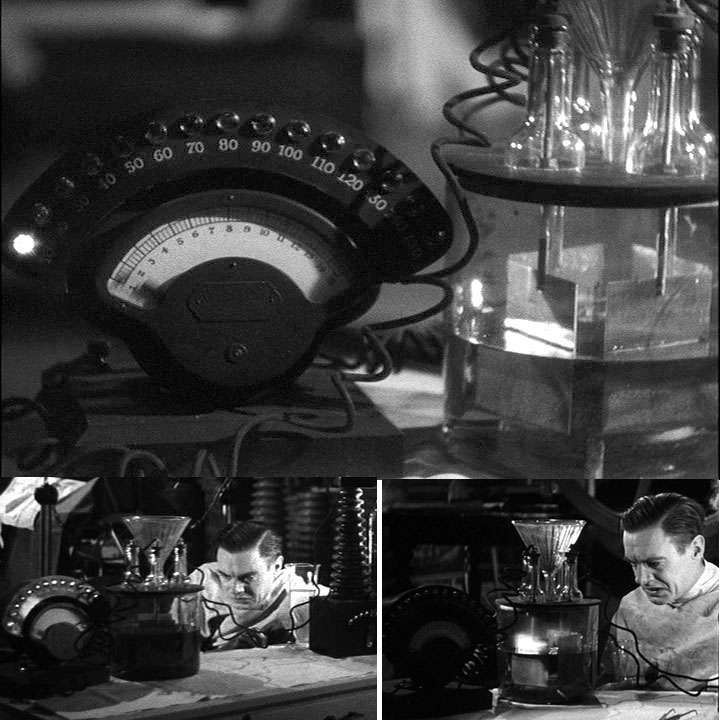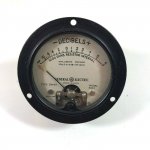I see lots of people put those cheap VU meters off ebay on their tube amps, but was wondering if it is possible to use a decibel meter for the same purpose, as i have some awesome vintage decibel meters and would love to incorporate them into a steampunk styled build.
Doesnt really need to accurately measure VU or anything, but just really to serve as a level meter to give some sort of indication to how much the amp is being driven.
Would they require shunting, or just hook up across the output?
Doesnt really need to accurately measure VU or anything, but just really to serve as a level meter to give some sort of indication to how much the amp is being driven.
Would they require shunting, or just hook up across the output?
They're great from a steampunk style (although if you're gonna do that - get the Frankenstein monster meter) but I suspect they're about as useful as a brick.

Source: Pin on Strickfaden

Source: Pin on Strickfaden
A real VU meter will read 0VU with a steady 1.228 VAC across itself plus a series resistor sized to make the total be 7500 Ohms. This would be about .19 Watts at 8 Ohms.
Leaving off the series resistor would get you a little more sensitivity, but it'll still be reading average voltage, not peak, so won't move much at ordinary listening levels to music. DIYers could easily add a meter driver stage and/or a peak hold if desired.
YOS,
Chris
Leaving off the series resistor would get you a little more sensitivity, but it'll still be reading average voltage, not peak, so won't move much at ordinary listening levels to music. DIYers could easily add a meter driver stage and/or a peak hold if desired.
YOS,
Chris
Last edited:
Do you have photo and a spec for the meter. The VU can be disappointing unless you run your amp near max power.
Its this here.
Meter says 1 DB - 1.73V, so im assuming 10.3V is the maximum it can handle on a scale to 6?
It would likely need a resistor to divide the voltage, as the speaker output is likely about 30-40VAC at maximum volume.
Attachments
6dB is twice the voltage, so about 3.5 Volts. But this is an *average*, not peak. That's a beautiful old meter, older than most of us.
You might want to make the series resistor adjustable; but even cranked wide open, much of the time, you shouldn't expect much deflection. Parties excluded!
YOS,
Chris
You might want to make the series resistor adjustable; but even cranked wide open, much of the time, you shouldn't expect much deflection. Parties excluded!
YOS,
Chris
6dB is twice the voltage, so about 3.5 Volts. But this is an *average*, not peak. That's a beautiful old meter, older than most of us.
You might want to make the series resistor adjustable; but even cranked wide open, much of the time, you shouldn't expect much deflection. Parties excluded!
YOS,
Chris
What part of the circuit are they typically connected to? Do they affect the sound quality?
Im assuming its OK to hook up across the speaker output on each channel?
The way I took it, was every dB was 1.75V, so multiplying that by the max reading at 6 dB would be 10.3V, or am i missing something?
Im assuming its AC volts, since the meter typically has a rectifier inside.
Last edited:
The scale distance from -6dB to 0dB is different than the scale distance from 0dB to 6dB.
Therefore, I expect there is a rectifier in the meter movement.
If there is no + and - marking on the input terminals, and no Red Dot or similar near one of the inputs, it has the rectifier inside.
By the way, a diode bridge rectifier, if used, will give the same answer if a DC supply is connected one way, and then connected the other way.
The proof will be in the pudding.
Please let us know whether the meter is DC or AC.
Therefore, I expect there is a rectifier in the meter movement.
If there is no + and - marking on the input terminals, and no Red Dot or similar near one of the inputs, it has the rectifier inside.
By the way, a diode bridge rectifier, if used, will give the same answer if a DC supply is connected one way, and then connected the other way.
The proof will be in the pudding.
Please let us know whether the meter is DC or AC.
Last edited:
VU meters are made to sit across studio line levels. Yours is made for a very old standard of 500 Ohm line and 0 VU of 6mW, which is 1.73 VAC. Later they were commonly made for 600 Ohm lines and 0 VU of +4dBm, which means 4dB above 1mW, which is 1.228 VAC. They're high enough impedance as to load the 500/600 Ohm line little enough as to not matter much, so speaker level impedances are a piece of cake.What part of the circuit are they typically connected to? Do they affect the sound quality?
Im assuming its OK to hook up across the speaker output on each channel?
The way I took it, was every dB was 1.75V, so multiplying that by the max reading at 6 dB would be 10.3V, or am i missing something?
Im assuming its AC volts, since the meter typically has a rectifier inside.
dB is a log scale, rather than linear. A Bel is the log of a power ratio of 10, and a dB is a tenth of that.
YOS,
Chris
lol Im forgetting that it starts at negative 10 dB on the scale!The scale distance from -6dB to 0dB is different than the scale distance from 0dB to 6dB.
Therefore, I expect there is a rectifier in the meter movement.
If there is no + and - marking on the input terminals, and no Red Dot or similar near one of the inputs, it has the rectifier inside.
By the way, a diode bridge rectifier, if used, will give the same answer if a DC supply is connected one way, and then connected the other way.
The proof will be in the pudding.
Please let us know whether the meter is DC or AC.
Going by what you say, it likely has a rectifier inside, since it doesnt have any markings indicating the polarity on the back, although i see aloth of other meters out there that have "rectifier type" printed on the dial.
This was nicknamed "Navy Meter". It was a good meter before the VU meter. It was NOT good for program (speech/music) because it was slow and confusing dynamics; made a great test-tone meter.
I had one 30 years ago and never got a useful "audio" response. They need significant power (this is where the VU meter is very much better). Even then the sluggishness makes an unexciting display (yet not sluggish enough to "read loudness").
I had one 30 years ago and never got a useful "audio" response. They need significant power (this is where the VU meter is very much better). Even then the sluggishness makes an unexciting display (yet not sluggish enough to "read loudness").
This was nicknamed "Navy Meter". It was a good meter before the VU meter. It was NOT good for program (speech/music) because it was slow and confusing dynamics; made a great test-tone meter.
I had one 30 years ago and never got a useful "audio" response. They need significant power (this is where the VU meter is very much better). Even then the sluggishness makes an unexciting display (yet not sluggish enough to "read loudness").
Well thats good to know, are there any vintage VU meters out there in that style?
The cheap ones on ebay are generic and I would rather put something vintage in if possible.
Would an AC voltmeter respond OK to an audio signal?
True Vu Meters were designed to have particular ballistics, including response rise-time to a transient, and transient overshoot response.
Broadcast personnel and Tape Recording Engineers learned how to interpret the Vu Meter needle movements to ensure they were using optimum levels of the program. That was in order to compromise distortion at high music levels versus signal level that was too low to be heard easily, and to be out of the system noise . . .
"Fit" the signal dynamic range into the broadcast or recording system's dynamic range, as well as possible.
If clipping or distortion happened, how long did it last; and if the low signal dropped into the noise, how far into the noise, and long did it last.
This was all an art and a science.
Having an ordinary AC meter that was designed to measure a steady AC voltage, is not likely to have the same ballistics as a true Vu meter.
Your Mileage May Vary.
Broadcast personnel and Tape Recording Engineers learned how to interpret the Vu Meter needle movements to ensure they were using optimum levels of the program. That was in order to compromise distortion at high music levels versus signal level that was too low to be heard easily, and to be out of the system noise . . .
"Fit" the signal dynamic range into the broadcast or recording system's dynamic range, as well as possible.
If clipping or distortion happened, how long did it last; and if the low signal dropped into the noise, how far into the noise, and long did it last.
This was all an art and a science.
Having an ordinary AC meter that was designed to measure a steady AC voltage, is not likely to have the same ballistics as a true Vu meter.
Your Mileage May Vary.
Im not really bothered if it doesnt behave as a VU meter with exact readings, just more of an indicator much like what people do with magic eye tubes.
Anyway, i see someone has made use of a millamperes meter to act as VU meter and seems to do the job.
He has explained it in some detail on this thread:
807 (maybe) amplifier build. Now EL34 - Page 12 - UK Vintage Radio Repair and Restoration Discussion Forum
I might be better off looking for a pair of millamperes meters or the likes.
Anyway, i see someone has made use of a millamperes meter to act as VU meter and seems to do the job.
He has explained it in some detail on this thread:
807 (maybe) amplifier build. Now EL34 - Page 12 - UK Vintage Radio Repair and Restoration Discussion Forum
I might be better off looking for a pair of millamperes meters or the likes.
- Status
- This old topic is closed. If you want to reopen this topic, contact a moderator using the "Report Post" button.
- Home
- Amplifiers
- Tubes / Valves
- Are decibel meters suitable for tube amps as a VU meter?
